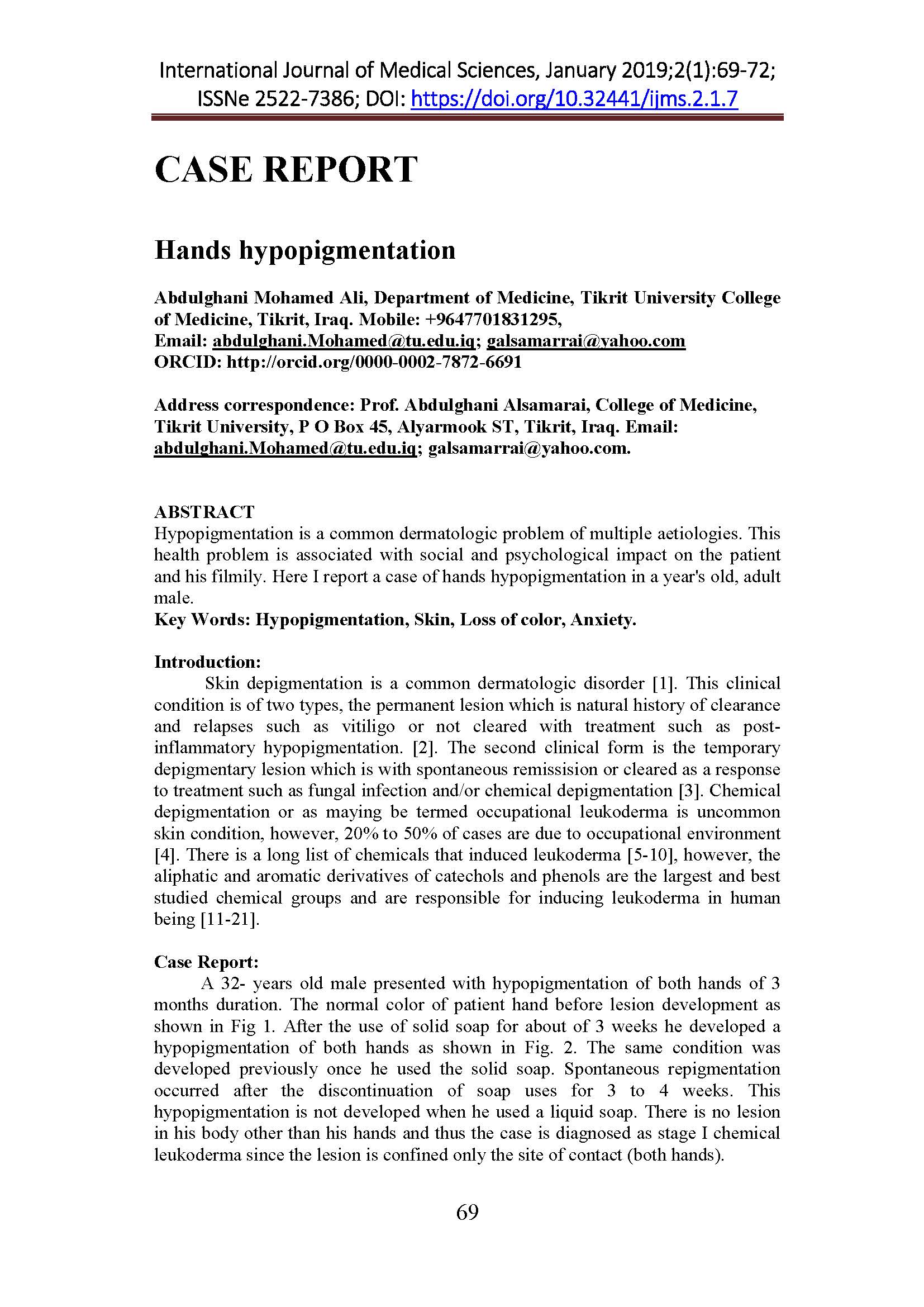Hands hypopigmentation
DOI:
https://doi.org/10.32441/ijms.2.1.7Keywords:
Hypopigmentation, Skin, Loss of color, Anxiety, ObsessionAbstract
Hypopigmentation is a common dermatologic problem of multiple aetiologies. This health problem is associated with social and psychological impact on the patient and his filmily. Here I report a case of hands hypopigmentation in a year's old, adult male.
Key Words: Hypopigmentation, Skin, Loss of color, Anxiety
References
Alsamarai AGM. Prevalence of skin diseases in Iraq. Int J Derm 2009; 48(7):734-9.
Lpeere H, Boone B, De Schepper S, Verhaeghe E, Van Geel M, Ongenae K, et al. Chapter 75. Hypomelanoses and Hypermelanoses. In: Goldsmith LA, Katz SI, Gilchrest BA, Paller AS, Leffell D, Wolff K (Eds.). Fitzpatrick's Dermatology in General Medicine, 8e. 2011. McGraw-Hill Education.
Al Samarai AM. Prevalence of skin diseases in Samara, Iraq. Middle East J Internal Med 2009; 2: 15-19.
Bonamonte D, Vestita M, Romita P, Filoni A, Foti C, Angilini G. Chemical leukoderma. Dermatitis 2016; 27(3):90-100.
Wattanakrai P, Miyamoto L, Taylor JS. Occupational pigmentary disorders. In: Wahlberg JE, Kanerva L, Elsner P, et al, eds. Handbook of Occupational Dermatology. Berlin, Germany: Springer; 2000:280-294.
Bonamonte D, Angelini G. Disordini pigmentari da contatto. Ann Ital Dermatol Allergol 2001;55:1-15.
Boissy RE, Manga P. On the etiology of contact/occupational vitiligo. Pigment Cell Res 2004; 17:208-214.
Ghosh S. Chemical leukoderma: what’s new on etiopathological and clinical aspects? Indian J Dermatol 2010; 55:255-258.
Miyamoto L, Taylor JS. Chemical leukoderma. In: Hann SK, Nordlund JJ, eds. Vitiligo: A Monograph on the Basic and Clinical Science. Oxford, England: Blackwell Science Ltd; 2000:269-280.
Rietschel R, Fowler JJ. Contact leukoderma (vitiligo) hyperpigmentation and discolorations from contactants. In: Rietschel R, Fowler JJ, eds. Fisher’s Contact Dermatitis. 5th ed. Philadelphia, PA: Lippincott Williams & Wilkins; 2001:571-579.
Kahn G. Depigmentation caused by phenolic detergent germicides. Arch Dermatol 1970; 102:177-187.
Malten KE, Seutter E, Hara I. Occupational vitiligo due to paratertiary butylphenol and homologues. Trans St Johns Hosp Dermatol Soc 1971; 57:115-134.
James O, Mayes RW, Stevenson CJ. Occupational vitiligo induced by p-ertbutylphenol, a systemic disease? Lancet 1977; 2(8050):1217-1219.
Gellin GA, Possick PA, Davis IH. Occupational depigmentation due to 4-tertiarybutyl catechol (TBC). J Occup Med 1970; 12:386-389.
Gellin GA, Possick PA, Perone VB. Depigmentation from 4-tertiary butyl catechol experimental study. J Invest Dermatol 1970; 55:190-197.
Bajaj AK, Gupta SC, Chatterjee AK. Contact depigmentation from free paratertiary- butylphenol in bind adhesive. Contact Dermatitis 1990; 22:99-102.
Rodermund OE. Letter: occupational vitiligo caused by paratertiary butylphenol. Arch Dermatol 1976; 112:554-555.
Calnan CD, Cooke MA. Leukoderma in industry. J Soc Occup Med 1974; 24:59-61.
Malten KE. Paratertiary butylphenol depigmentation in a ‘‘consumer’’. Contact Dermatitis 1975; 1:181-182.
Malten KE. Dermatological problems with synthetic resins and plastics in glues. Part I. Derm Beruf Umwelt 1984; 32:81-86.
Horio T, Tanaka K, Komura J. Depigmentation due to paratertiarybutyl catechol. Int Arch Occup Environ Health 1977;39:127-133
Bellono NW, Oancea EV. Ion transport in pigmentation. Arch Biochem Biophys 2014;365:35-41.
Bellano NW, Escobar IE, Oancea EV. A melanosomal two-pore sodium channel regulates pigmentation. Sci Rep 2016; 6:26570; doi: 10.1038/srep26570 (2016).
American Pharmaceutical Association. Handbook of Non-prescription Drugs. 1996.
Filipsson AF, Bard J, Karlssons S. Concise International Chemical Assessment Document 5. Limonene. WHO, Geneva, 1998.
WHO- International Agency for Research on Cancer. IARC Monograph 2000; 77:193-225.

Downloads
Published
Versions
- 2019-01-01 (2)
- 2022-05-20 (1)
